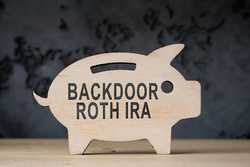Open-End vs. Closed-End Funds: Differences & How To Choose

Our evaluations and opinions are not influenced by our advertising relationships, but we may earn a commission from our partners’ links. This content is created by TIME Stamped, under TIME’s direction and produced in accordance with TIME’s editorial guidelines and overseen by TIME’s editorial staff. Learn more about it.
Mutual funds are a popular way to diversify an investment portfolio without buying individual stocks, bonds, and other securities. If you invest in mutual funds, you might already be familiar with open-end funds: Funds that issue an unlimited number of shares based on investor demand. Lesser known are closed-end funds, which issue a fixed number of shares at an initial public offering (IPO).
Both funds pool investor money to invest in a diversified portfolio of assets, and both are usually actively managed. However, there are some key differences to consider before deciding whether open-end or closed-end funds are right for your investment portfolio.
Most mutual funds are open-end funds. These funds continuously offer new shares for sale, creating new shares when investors buy and removing shares from circulation as investors sell. The number of shares the fund can issue is unlimited.
Open-end funds are priced according to net asset value (NAV), which is the value of the fund’s assets minus its liabilities. For example, a fund with $100 million worth of cash and securities in its portfolio and $10 million in liabilities will have a NAV of $90 million.
To determine the net asset value per share (NAVPS)—the price at which investors buy and sell shares—divide NAV by the number of shares outstanding. So, a fund with a NAV of $90 million and 10 million shares in circulation will have a NAVPS (or per share value) of $9.
| Pros | Cons |
|---|---|
|
|
Open-end funds freely issue new shares to meet investor demand. As implied in their name, they’re always open to receiving new investments and new capital. And because they track their NAV closely, they tend to offer less volatility and more predictable pricing than their closed-end counterparts.
Open-end funds are priced once daily at the end of trading, so you may have to wait for your buy or sell order to fill and not get the same price you saw when you executed the transaction.. Moreover, open-end funds must maintain cash reserves to cover redemptions, meaning they can’t invest 100% of their assets. This results in some of your capital not actually being invested, which translates to lower potential returns.
Unlike open-end funds, closed-end funds aren’t open to new investments and capital. They raise capital and offer a fixed number of shares during an IPO period. After the IPO, shares of the fund trade on an exchange just like stocks and exchange-traded funds (ETFs).
Closed-end fund prices fluctuate throughout the trading session, often above (at a premium) or below (at a discount to) their NAV.
| Pros | Cons |
|---|---|
|
|
Closed-end funds trade on exchanges, so you can buy and sell shares throughout the trading session. Share prices are determined by supply and demand, meaning it’s possible to buy the underlying assets at a discount. Closed-end funds offer higher potential returns than open-end funds because they can put100% of their assets to work and are able to invest in specialized, less liquid parts of the market.
A closed-end fund’s liquidity depends on investor supply and demand, so it can be less liquid than an open-end fund. These funds are also subject to increased volatility because shares can trade above or below their NAV. Another potential drawback is that many closed-end funds use leverage. This can enhance returns but also increases risk and can amplify losses.
| Open-end fund | Closed-end fund | |
|---|---|---|
Number of shares issued | Unlimited | Limited to IPO |
How the fund trades | Trade directly with investment firm | Trade on exchanges like stocks |
How the fund is priced | NAV | Market price |
% of funds invested | Not 100% invested | Often 100% invested |
An open-end fund is always open to new investors, so it continuously offers new shares for sale (and accepts new capital) according to investor demand. A closed-end fund, on the other hand, issues a fixed number of shares and raises all its capital at an IPO.
Investors buy and sell stakes in open-end funds directly from the fund or through a broker for the fund. Closed-end funds are different. After the fund’s IPO, the shares in circulation are traded by investors on a national exchange such as the New York Stock Exchange (NYSE). In this secondary market, the shares can be bought and sold throughout the day like a stock or exchange-traded fund (ETF). Investors can place trades via their broker’s online trading platform or work with a financial advisor. If you aren’t comfortable investing alone and require help, consider using a service like WiserAdvisor, which can match you with a vetted financial advisor aligned with your specific needs.
Open-end funds are priced and traded once daily at the fund’s NAV, which is calculated after the major U.S. exchanges close. Meanwhile, closed-end funds trade throughout the day at their current market price, which fluctuates throughout the trading session based on supply and demand. The market price is rarely the same as the NAV: Shares trade at a “discount” when the share price is lower than the NAV and at a “premium” when the share price is higher than the NAV.
A portion of an open-end fund’s assets must be kept in cash to pay investors who redeem shares, so not all assets will be invested. That isn’t an issue for closed-end funds. These funds don’t need to maintain cash reserves or sell securities to meet redemptions as the number of shares are fixed. This means they can invest all of their investors’ capital. It also means a closed-end fund can invest in less-liquid securities, such as emerging-market stocks and thinly traded municipal bonds, which can translate into higher shareholder returns.
Open-end funds are more common than closed-end funds and are often a component in employer-sponsored retirement plans, such as 401(k)s. They’re a smart choice for investors who prefer a fund with less risk and more predictable pricing and returns. However, the trade-off is that open-end funds don’t offer the same earnings potential as closed-end funds.
Closed-end funds are ideal for investors who are comfortable taking on more risk in exchange for higher potential returns. They also make sense if you want to buy and sell funds on an exchange throughout the trading day to exploit price fluctuations. A closed-end fund can be especially attractive when it can be bought at a discount; that is, when it’s trading below its NAV.
As with any investment, it’s important to consider the trading costs associated with open-end and closed-end funds. Fees can erode your earnings over time.
Open-end funds charge an annual expense ratio to cover management, administration, and distribution costs. Some funds also impose a sales charge or “load” when you buy (front-end load) or redeem (back-end load) shares. The Securities and Exchange Commission (SEC) doesn’t limit the sales loads a fund can charge, but the Financial Industry Regulatory Authority (FINRA) caps sales loads at 8.5% of the purchase or sale.
Closed-end funds also charge an expense ratio, which includes an interest expense if it’s a debt-leveraged fund. However, it’s helpful to look at the adjusted expense ratio (without the interest expense) to determine whether the leverage has been profitable. Because closed-end funds trade on an exchange, you might also owe a broker commission and transaction fee.
Consider working with a financial advisor to learn more about open-end and closed-end funds and their tax consequences, or if you need help choosing investments suitable for your financial goals and risk tolerance.
Most mutual funds are open-end funds. ETFs can also be open-end funds, though some are structured as unit investment trusts (UITs). Examples of popular open-end funds include the Vanguard Total Stock Market Index Fund (VSMPX), Vanguard 500 Index Fund (VFIAX), and Fidelity 500 Index Fund (FXAIX).
A key difference between open-end and closed-end funds is how they trade. Open-end funds trade at the end of each trading day at their NAV, while closed-end funds trade like stocks on an exchange. Another distinction is that open-end funds continually offer new shares to investors, while closed-end funds offer a finite number of shares during an IPO period, which are then traded between investors on an exchange.
Yes, you can buy and sell shares of a closed-end fund throughout the trading day on a market exchange.
The information presented here is created by TIME Stamped and overseen by TIME editorial staff. To learn more, see our About Us page.



